A new product or service has a long development process from start to finish. You should find a new product idea, create a prototype, test it in real market conditions, and launch it. Between all these major stages, there are more. Assume that you completed each step perfectly, and now it is time to market your product efficiently and effectively, but how? There are a number of options. We can examine these options under two topics: Direct and indirect marketing. In today’s comprehensive guide, we’ll zoom on the second one. Well, we’ll first introduce the indirect marketing definition.
After we cover what this type of marketing is, we’ll dive into its advantages. All these advantages focus on enhancing brand recognition and raising awareness about the product or service. Third, we would like to compare direct marketing with indirect one. Fourth, we’ll look at major types of this marketing strategy, including SEO, content marketing, social media marketing, word-of-mouth, product placement, public relations, podcasts, and live events. If you feel confused, don’t worry. We’ll provide a better insight into these titles by giving perfect examples at the end of our guide. Are you ready? Let’s dive into our topic!
What Is Indirect Marketing?
Indirect marketing refers to a marketing approach where the marketer does not directly attract the attention of a potential group of customers for sale. Instead, the marketer creates an environment that helps discover the product/service and purchase it for the end customer. So, we can definitely say that this type of marketing aims to create trust and establish a strong relationship between potential customers at its initial stage. You can also check what is marketing mix to learn more details about the marketing process. At this point, there are several advantages of this marketing strategy.

Advantages of Indirect Marketing
Let’s now look at the advantages of indirect marketing closely.
Create a brand and product or service awareness.
Creating brand and product/service awareness is a key factor of marketing and can significantly impact your business’s success. Here, indirect marketing allows any business to create brand familiarity. It involves introducing your brand and products/services to the target audience and creating an understanding of what your brand represents and what your products or services provide.
Improve trust and credibility.
When potential customers observe a product or service being recommended by others, they are more likely to trust your business. In return, you can increase your sales and turn target customers into loyal ones.
Attract a wider audience.
Social media and word-of-mouth are the most commonly observed types of indirect marketing. To reach a larger audience, allow your business to attract consumers who may not have been reached through traditional advertising methods, such as TV commercials and print ads in newspapers or magazines.
Improve customer engagement.
Indirect marketing involves user-generated content (UGC), referring to the content created by internet users themselves – such as comments, reviews, photos, or videos. These all encourage customer engagement and interaction, enabling you to understand your customers’ thoughts and feelings and create a positive customer experience.
Reduce advertisement budget.
It is a fact that traditional advertising methods like TV commercials are too expensive. However, indirect marketing is cost-effective for businesses of all sizes, from the world’s leaders to small home businesses.
Drive organic traffic to your business website.
Instead of being generated through paid advertising, organic website traffic may come from various sources like search engines or social media. And indirect marketing helps you drive high-quality traffic to your web pages through SEO strategies or hashtags on social media.
Indirect vs. Direct Marketing
Indirect and direct marketing goals are the same: generating organic traffic to your business website by attracting profitable customers and selling your products or services. However, the methods of achieving these objectives are different. Now, we would like to compare the two marketing methods. Let’s start with direct marketing!
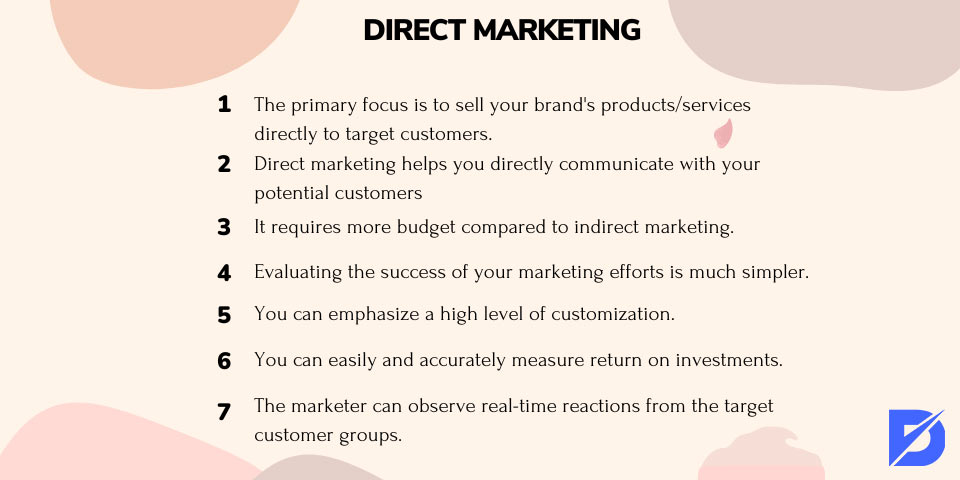
Direct Marketing
- The primary focus is to sell your brand’s products/services directly to target customers through advertisements, direct mail, or telemarketing.
- Direct marketing helps you directly communicate with your potential customers by promoting and selling a product/service.
- It requires more budget compared to indirect marketing.
- Evaluating the success of your marketing efforts is much simpler.
- You can emphasize a high level of customization. For example, it is possible to send targeted emails to each target customer.
- You can easily and accurately measure return on investments (ROI), which indicates the efficiency of your marketing strategy.
- The marketer can observe real-time reactions from the target customer groups due to simultaneous interaction.
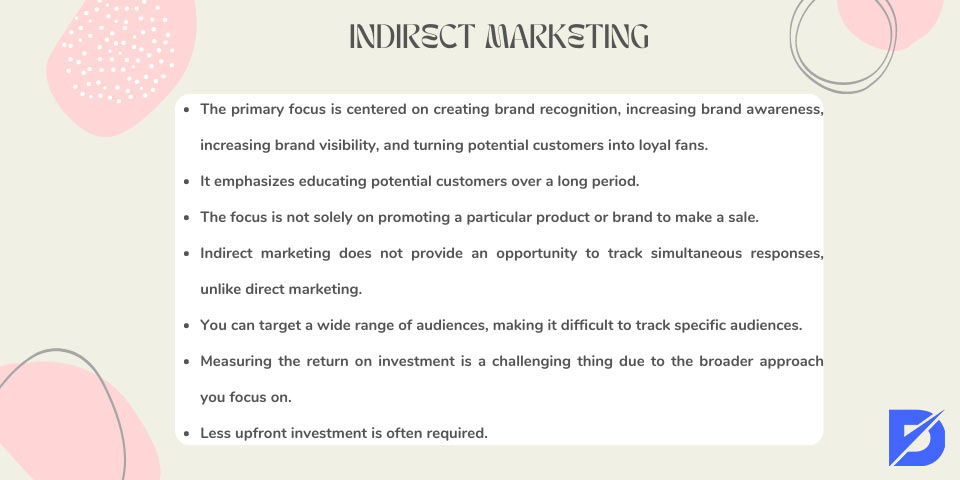
Indirect Marketing
- The primary focus is on creating brand recognition, increasing brand awareness and visibility, and turning potential customers into loyal fans.
- It emphasizes educating potential customers over a long period.
- The focus is not solely on promoting a particular product or brand to make a sale. Instead, it requires a broader approach, for example introducing a new product to a wider audience.
- Unlike direct marketing, indirect marketing does not provide an opportunity to track simultaneous responses.
- You can target a wide range of audiences, making it difficult to track specific audiences.
- Measuring the return on investment is a challenging thing due to the broader approach you focus on.
- Less upfront investment is often required.
Types of Indirect Marketing to Help Grow Your Brand
Now that we’ve covered the main advantages, we can now examine its types. As you may guess, different types of indirect marketing strategies can help you attract the attention of target customers, such as:
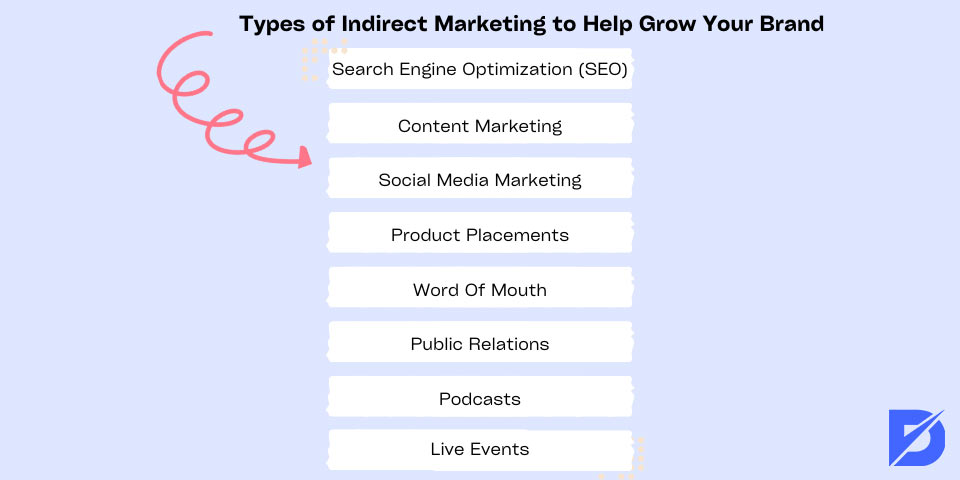
Search Engine Optimization (SEO)
Search Engine Optimization, or SEO for short, is a method to optimize a website and its web pages to improve its visibility in search engine results pages (SERPs). It is especially important for promoting web page content to drive more organic visitors from Google and other search engines. In other words, SEO allows a website owner to make their website more attractive to Google and its valuable users. At this point, on-page optimization plays a vital role in indirect marketing. Also, learn why is SEO important in digital marketing for further knowledge. So, if you are ready, let’s quickly introduce it.
To be ranked higher on Google, you should emphasize some points on your website.

- High-Quality Page Content: The most important thing is to provide valuable and unique content to target visitors. It is essential for user experience, SEO, credibility, and engagement.
- Page Titles (also known as title tags): These appear on search engine results and provide a brief description of what the page content is about.
- Meta Description: The meta description refers to information that provides a brief content summary on your web pages. This information is placed in the head section of the web page in search engine results pages (SERPs).
- URL structure: URLs you use on your website should be SEO-friendly, so make them short, descriptive, and beautiful.
- Canonical URL: The purpose of using canonical URL, rel-“canonical,” is to help prevent duplicate content by specifying the preferred version of a web page to Google.
- Image Optimization: It is essential to use unique images relevant to the page in the highest quality format possible. Besides, reducing the size of your image file is very important for increasing the upload speed. Moreover, you should utilize the “Alt Text” to help search engines understand what the image is about.
- Theme Optimization: Visuality (for example, using a catchy theme), easy-to-use navigation, speed, visitor engagement, and user satisfaction play an essential role in your place in SERPs.
Content Marketing
Content marketing involves the creation, distribution, and utilization of various forms of valuable and educational media, such as text, images, blog posts, infographics, videos, or audio. Like other indirect marketing strategies, the purpose is to build relationships, achieve business objectives, and educate and inform the target customers about your brands or products/services. However, the difference is that the focus is not on selling a product or service but rather on educating or entertaining the target audience. This can be achieved through various print and digital channels, including websites, mobile applications, social media platforms, etc.
Content marketing can be effectively used to reach target customers and drive organic traffic, as it lets marketers offer unique data and insights to their target audience rather than directly selling to them.
Content marketing also includes user-generated content, or UGC for short, referring to any content created and shared by users, like comments, photos, videos, feedback, and reviews. We can mostly see this type of content on social media platforms – like Instagram or TikTok or forums – like Quora. User-generated content can indeed bring several benefits to your brand, including.
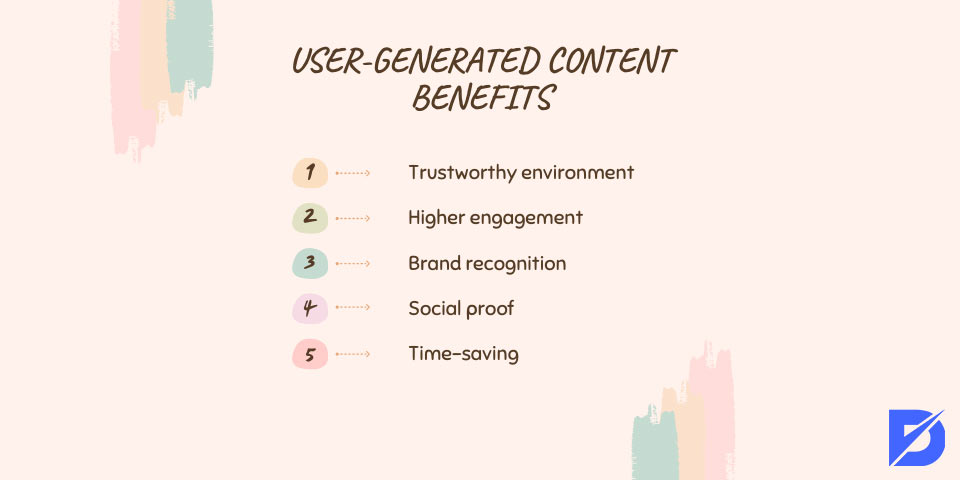
- Trustworthy environment: User-Generated Content plays a crucial role in establishing a trustworthy and valuable environment as actual customers share the content.
- Higher engagement: Since comments, reviews, or photos are types of UGC, it helps you improve engagement and interaction on online platforms.
- Brand recognition: UGC allows your business to spread the word about your products and services to more people.
- Social proof: UGC can show your brand’s worth by sharing the real positive experience with your products to others who have not purchased from your brand.
- Time-saving: Since your customers create and share photos, videos, or comments with you, you can reduce the total time you spend creating your own content.
Social Media Marketing
Marketing your brand on social media is one of the most cost-effective methods. Social media engagement is crucial for brand recognition and increasing brand awareness.
As you may know, social media platforms are where your target audience and the general population are located. For this reason, using the right platform(s) is important. At this point, when choosing the right social media network, remember that the purpose is to connect with family and friends. So, you should be careful about how you can use the platform for your business purposes. With the help of social media, you can:

- Create brand recognition and increase brand awareness,
- Reach a wider audience,
- Increase organic traffic to your business website, potentially leading to more sales and conversions,
- Gain a competitive advantage over your rivals,
- Build strong relationships with your customers and turn them into loyal fans,
- Increase the number of sales with collaborating business partnerships like influencers,
- Reduce your costs and focus on different areas with your current budget,
- Improve search engine optimization (SEO), helping you to be ranked higher in search results,
- Offer targeted ads that allow you to specifically target your potential customers by age, gender, location, occupation, and interests.
Product Placements
This type of indirect marketing refers to a strategy that uses your brands, products, or services in a movie, video game, TV show, etc. The purpose is to enhance brand recognition and raise brand awareness by making the product/service seem like a part of the scene. Such a type of advertising method is generally undetected by viewers, but it still has a considerable influence on consumer buying patterns. To give an example, while watching one of the hit television series, “Fringe,” you often witness Olivia Dunham and Peter Bishop use Dell computers in their investigative duties. Or, in the world’s most famous serial killer series, Dexter, you can see different brand placements, such as Dexter’s iMac, Doritos packages in The Best Cuban Food stand, or the number one tequila brand in the world, Jose Cuervo.
Word of Mouth
Word-of-mouth marketing, or WOM, also known as referral marketing, is one of the most used forms of marketing that gives target customers a reason to mention your brand. In other words, people spread the word about your brand’s products or services to their families, friends, relatives, colleagues, neighbors, and even social media platforms. It is especially crucial for creating powerful trust and credibility among people all around the world. We can see this marketing method in different forms, from satisfied customer comments to consumer complaint forums.
It is clear that WOM does not allow the manipulation of brands. This is because it is a natural process that allows real customers to share their positive or negative experiences with a product/service, or brand. If a company tries to manipulate or control WOM through deceptive methods like fake reviews or comments, losing customers’ confidence is inevitable.
There are different methods you can see in a WOM campaign. Of course, there is one common goal between these methods. And they are: Increasing awareness about your brand or product by sharing positive experiences.
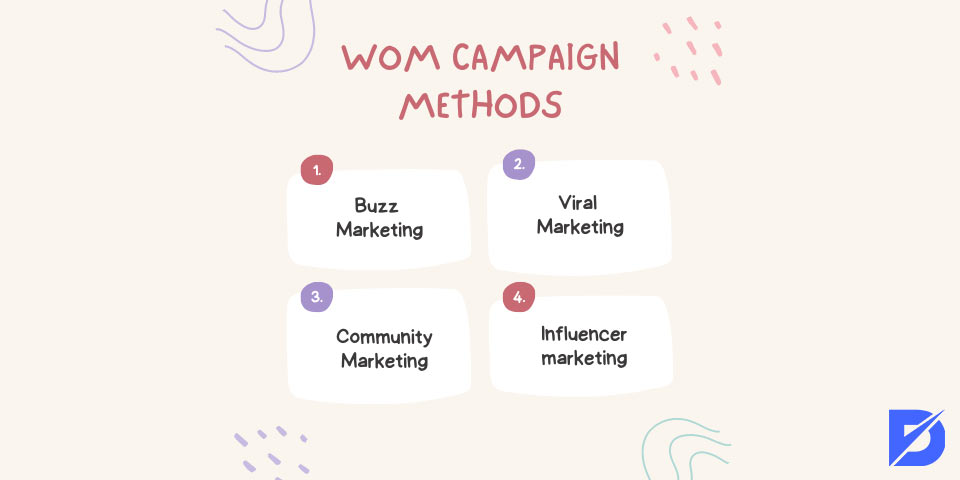
- Buzz Marketing: Involves popular entertainment or news events to generate discussions and interest around your band.
- Viral Marketing: Designing and sharing educational messages that are intended to be widely shared and spread.
- Community Marketing: Attracting the attention of specialized groups with a common interest in the brand (like fan clubs or discussion forums).
- Influencer marketing: Targeting key communities and their opinion leaders who have a significant impact on the ability to influence the ideas of others.
For example, Netflix utilizes behavioral analysis to suggest series, movies, and shows based on the users’ preferences. Or the world’s number one music platform, Spotify, shares Spotify Wrapped, which has been a huge success. So, you can share the music you mostly listen to with your besties.
Public Relations
Public relations, or PR for short, is a type of media that allows you to improve the relationship between your business and target audience. The significance of effective PR in the growth of a business is clear. An efficient PR strategy helps you create a reliable and trustworthy image in the eyes of the target audience.
As we all know, PR can bring a variety of benefits to your business, such as:
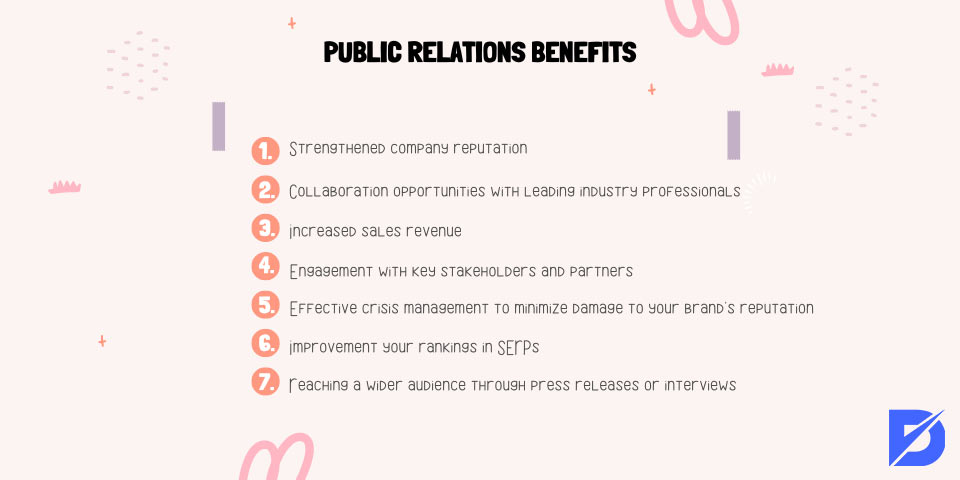
- Strengthened company reputation
- Collaboration opportunities with leading industry professionals
- Increased sales revenue
- Engagement with key stakeholders and partners
- Effective crisis management to minimize damage to your brand’s reputation
- Improvement your rankings in SERPs
- Reaching a wider audience through press releases or interviews
Podcasts
The popularity of podcasts has grown significantly. And they provide a valuable opportunity for your business to engage in indirect marketing. This type of method involves the promotion of your brand and its products/services through podcast sponsorship. Based on this strategy, you pay for an advertisement during a single podcast episode. Here, the ad usually includes vital information about your product and brand while discussing first-hand experience. Promo codes or discounts may also be offered to encourage the listeners of your podcast.
Live Events
Live events are another method to create brand awareness and improve customer engagement. This strategy allows you to meet with your target customers in person and build real-life connections with them. The purpose is to create a unique experience that enables potential customers to participate in the event. At this point, you can be the organizer, a participant, or a sponsor. In the past, live events were primarily face-to-face. However, with the advancement of technology, we can also see live online events.
Indirect Marketing In Short
Indirect marketing is a type of marketing that tries to create an environment that makes it easy for potential customers to discover and then purchase a product or service rather than directly selling your products to these customers. In today’s article, we tried to explain it in a very detailed way. This marketing strategy is especially crucial for start-ups or new product owners. If you have just created a new brand or launched a new product in the current market, indirect marketing will be able to build a strong awareness and build a strong foundation for future sales and growth. This marketing strategy can offer a cost-effective way to target a broad range of people. And this will also help deliver results that exceed your expectations.
One last thing left: Creating and sharing valuable, relevant content is an essential aspect of marketing that can benefit businesses. It helps to raise brand awareness, establish trust and credibility with audiences, and ultimately drive sales and foster customer loyalty.
You may also want to read our What are Bumper Ads article.
Frequently Asked Questions About
There are various channels you can focus on. SEO, sponsorships, social media influencers and fan pages, product placements, word-of-mouth, referrals, podcasts, live events, or online reviews are some channels you can use.
The types of content marketing can be extensive, including text, images, blog posts, videos, audio, infographics, podcasts, online games, live events, and quizzes.
This type of marketing requires patience because the results you will receive tend to increase gradually over time. Furthermore, unlike other marketing methods, it can be challenging to measure results as it targets a larger audience, including both real potential customers and customers unrelated to what you sell, leading to the potential waste of efforts and budget allocation.
Direct marketing is a marketing form that directly tries to reach a targeted audience, while indirect marketing is a form of marketing that aims to create brand awareness and increase brand recognition without directly targeting customers.
It plays a crucial role in shaping customer experience as it helps you create a positive image for a brand or its products. Observing others who are satisfied with a product can help you increase the trust of targeted customers and encourage them to make a purchase.

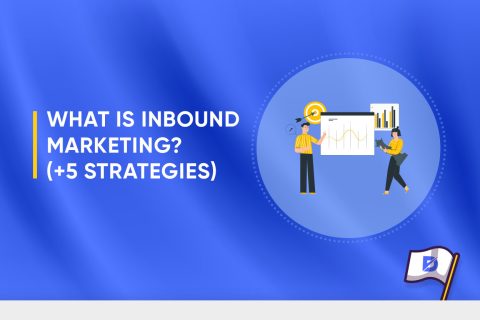


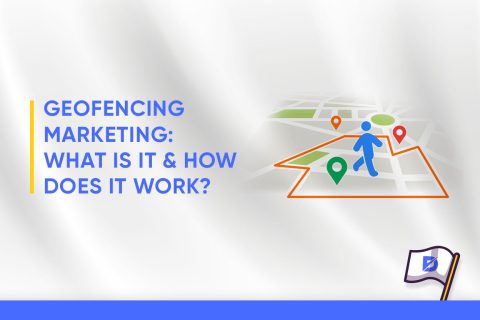
No comments to show.